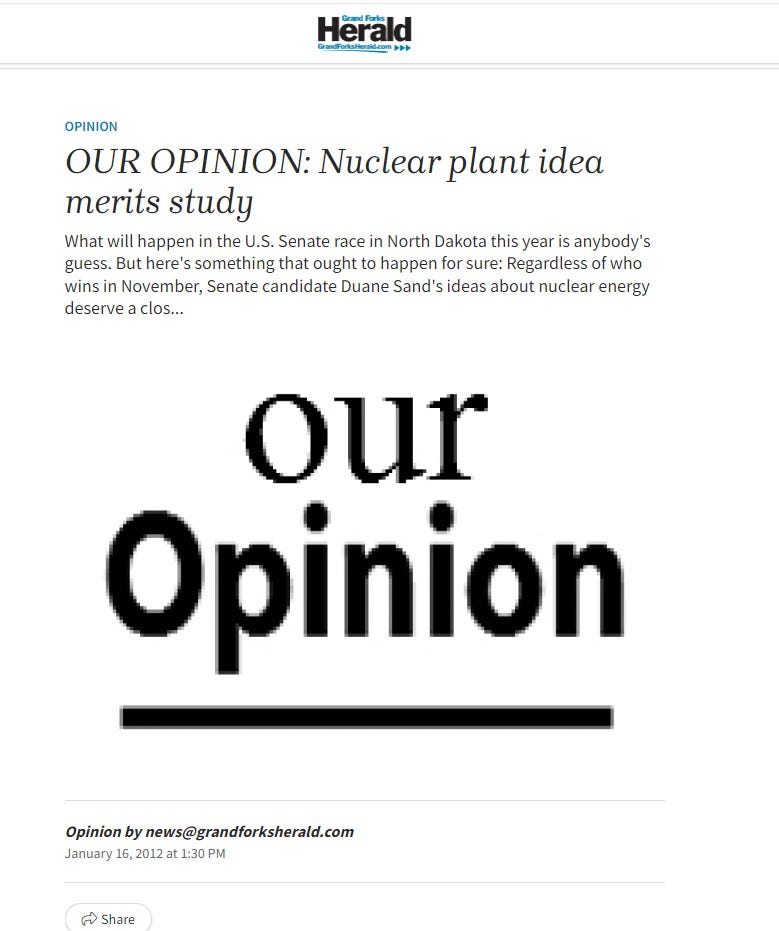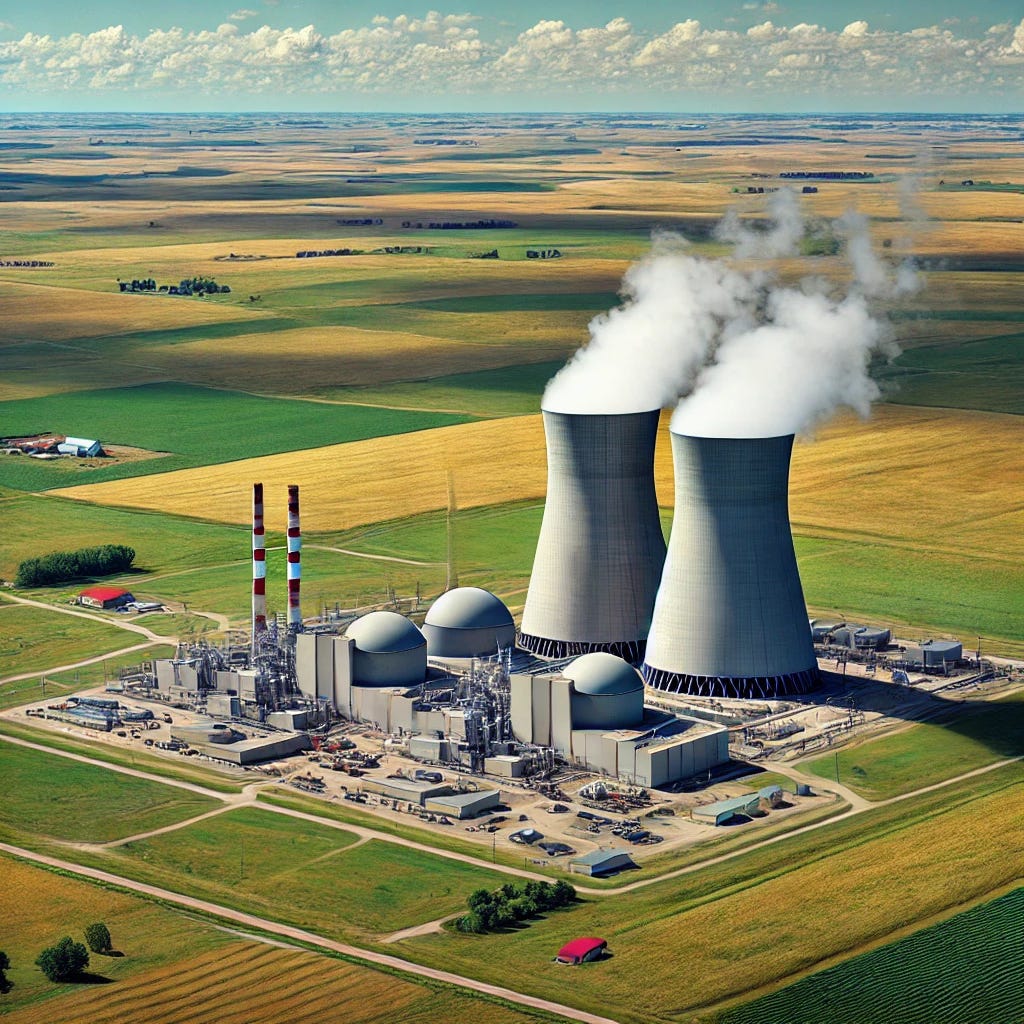Earlier this year, I wrote about how there is renewed interest in nuclear power as it is obvious that to fill the need to transitioning to electrict vehicles will require far more electrical capacity than wind and solar can provide in a world where coal fired power plants are under attack and being shutdown voluntarily by the utility companies themselves.
In the last few weeks, the interim legislative committees working on this issue have started to wrap up what they plan to pitch to the next legislative session.
Nuclear power may be part of the solution for North Dakota’s growing energy demand but the issue is so complex that the state should invest more time and money into a study, the chair of an interim legislative committee said.
State Senate Majority Leader David Hogue, R-Minot, said public opinion has shifted on nuclear energy. People see it as “safe, efficient and dispatchable.”
Hogue has drafted a bill proposing that the state spend $500,000 to further study nuclear energy. Hogue chairs the Energy Development and Transmission Committee that was tasked with studying nuclear energy leading up to the 2025 legislative session.
“It’s overwhelming for an interim legislative committee,” Hogue said during a meeting of the committee Thursday near Beulah, where the committee toured the Dakota Gasification Plant owned by Basin Electric Power Cooperative.
The draft bill requests up to $500,000 from the state general fund to hire private consultants for the study.
Hogue said that citizen legislators lack the expertise to tackle an issue such as nuclear energy without the help of consultants.
The bill draft also seeks a $500,000 commitment from the private sector for the study.
In the video at the top of this article, Duane Sand is talking to Gary Emineth on BEK-TV about bringing nuclear power to North Dakota - an idea he has been pushing for a very long time.
An idea that statewide media has actually said is worth looking at.
From the Grand Forks Herald back in 2012:
* First, the Red River Valley lies in the heart of one of the most geologically stable regions of the nation. One of the major concerns about existing nuclear plants is that they were built in or near earthquake zones.
* Second, the technology has advanced so that plant designs, safeguards and generating capacities are far more sophisticated than they used to be. Licensing and permitting procedures are not as byzantine as in the past.
* Third, up to a third of the existing nuclear plants in the nation will be retired in the coming years. They are old and in some instances structurally fatigued. They won't be repaired; they will be shut down. They represent a significant percentage of the nation's electrical generating capacity. Replacing them with new nuclear plants in stable and grid-accessible regions of the country makes sense.
* Finally, the myths associated with nuclear power's dangers need to be exposed as mostly frauds. Since the Three Mile Island breach several years ago, nuclear power opponents have used the incident as an example of nuclear power gone wrong. But the reality of that overblown story is that no one was injured, discharges of radiation were minimal, and the failure was contained. It was not a Chernobyl-type disaster that was caused by faulty Russian design and operation.
With the recent national news that two seperate nuclear plants that had previously been shut down will be allowed to come back online, the time is ripe for North Dakota to make itself part of this dicussion.
The Energy Department said on Monday that it had finalized a $1.52 billion loan guarantee to help a company restart a shuttered nuclear plant in Michigan — the latest sign of rising government support for nuclear power.
Two rural electricity providers that planned to buy power from the reactor would also receive $1.3 billion in federal grants under a program approved by Congress to help rural communities tackle climate change.
The moves will help Holtec International reopen the Palisades nuclear plant in Covert Township, Mich., which ceased operating in 2022. The company plans to inspect and refurbish the plant’s reactor and seek regulatory approval to restart the plant by October 2025.
After years of stagnation, America’s nuclear industry is seeing a resurgence of interest. Both Congress and the Biden administration have offered billions of dollars in subsidies to prevent older nuclear plants from closing and to build new reactors. Despite concerns about high costs and hazardous waste, nuclear plants can generate electricity at all hours without emitting the greenhouse gases that are heating the planet.
David Turk, the deputy secretary of energy, said he expected U.S. electricity demand would grow by 15 percent over the next few years, driven by an increase in electric vehicles, a boom in battery and solar factories as well as a surge of new data centers for artificial intelligence. That meant the nation needs new low-carbon sources of power that could run 24/7 and complement wind and solar plants.
This is in addition to Microsoft bringing one of the Three Mile Island units back online:
In a striking sign of renewed interest in nuclear power, Constellation Energy said on Friday that it plans to reopen the shuttered Three Mile Island nuclear plant in Pennsylvania, the site of the worst reactor accident in United States history.
Three Mile Island became shorthand for the risks posed by nuclear energy after one of the plant’s two reactors partly melted down in 1979. The other reactor kept operating safely for decades until finally closing, for economic reasons, five years ago.
Now a revival is at hand. Microsoft, which needs tremendous amounts of electricity for its growing fleet of data centers, has agreed to buy as much power as it can from the plant for 20 years. Constellation plans to spend $1.6 billion to refurbish the reactor that recently closed and restart it by 2028, pending regulatory approval.
“The symbolism is enormous,” said Joseph Dominguez, chief executive of Constellation, the nation’s largest nuclear operator. “This was the site of the industry’s greatest failure, and now it can be a place of rebirth.”
This is in addition to the work backed by Bill Gates in Wyoming for smaller nuclear modules:
Bill Gates and his energy company are starting construction at their Wyoming site for a next-generation nuclear power plant he believes will “revolutionize” how power is generated.
Gates was in the tiny community of Kemmerer Monday to break ground on the project. The co-founder of Microsoft is chairman of TerraPower. The company applied to the Nuclear Regulatory Commission in March for a construction permit for an advanced nuclear reactor that uses sodium, not water, for cooling. If approved, it would operate as a commercial nuclear power plant.
The site is adjacent to PacifiCorp’s Naughton Power Plant, which will stop burning coal in 2026 and natural gas a decade later, the utility said. Nuclear reactors operate without emitting planet-warming greenhouse gases. PacifiCorp plans to get carbon-free power from the reactor and says it is weighing how much nuclear to include in its long-range planning.











Share this post